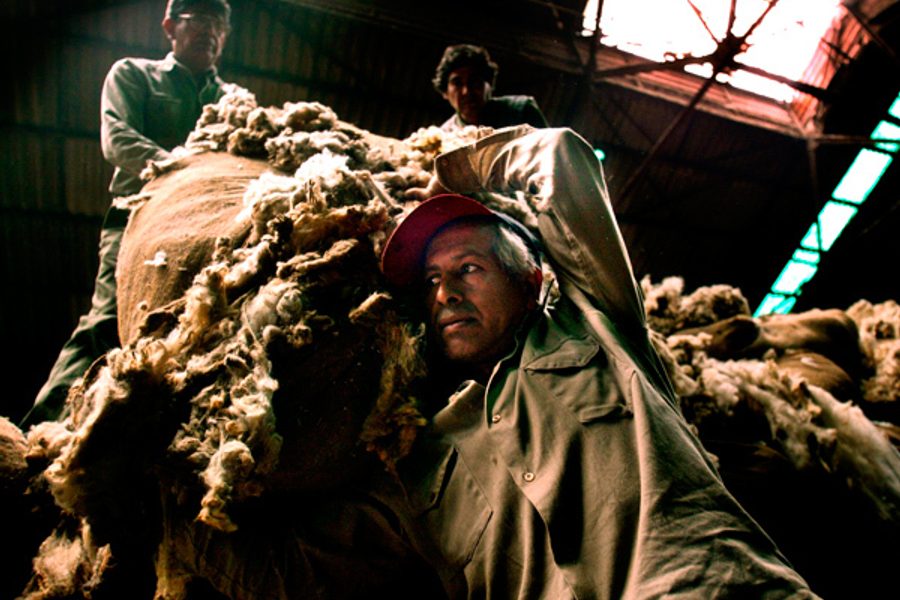
BUENOS AIRES, ARGENTINA – “Work is work, politics belongs somewhere else,” says Placido Peñarrieta, a lithe and graying worker at Arte Grafica Chilavert (Graphic Art Chilavert), an Argentine print shop. But what is occurring in this warehouse in Buenos Aires’ Nueva Pompeya neighborhood – thought to be where tango originated – and in many other workplaces across the country is most definitely a political act. Nearly 10 years after the rapid fall of Argentina’s economy, the country’s worker-occupied cooperatives persevere, a radical experiment in restructuring the capitalist status quo.
What started as desperate solutions to a severe economic crisis have evolved into established business models. “What the recuperated factories in Argentina are showing is a model of economic justice,” says Eduardo Murúa, founder of the National Movement of Recuperated Businesses (MNER), an organization tying together workers at the various Argentine worker-run businesses. The nearly 200 businesses, which employ close to 10,000 people, are worker-managed and worker-operated, with many paying equal wages regardless of position or experience.
But divisions within the movement, apathy from the center-left Kirchner/Fernandez government, and a lack of capital threaten the future of both the workers’ factories and their movement.
Argentina’s collapse, and neoliberal response
The formation of many of these worker-run cooperatives resulted from the lesson in economic collapse that Argentina received between 1999-2002. “The economy contracted by almost 30 percent, and unemployment exploded,” says Professor Sebastian Saiegh, of the Center for Iberian and Latin American Studies (CILAS) at the University of California San Diego (UCSD).
Argentine President Carlos Menem implemented a slew of neoliberal reforms between 1989 and 1999, including opening up the country’s financial markets and privatizing numerous national industries. This earned the country praise from the International Monetary Fund.
Despite Menem’s best effort and his privatization schemes, in the wake of the 1997 East Asian and 1998 Brazilian financial crises, investors began fearing that debt-laden Argentina might default on its loans. Capital flight wreaked havoc on the country. In 2001, the nation faced runs on the bank, eviscerated savings accounts and massive unemployment.
Occupiers network
The severity of the economic meltdown caused workers to innovate new modes of job creation. Many Argentinean workers dealt with their sudden unemployment proactively. In some workplaces, employees broke into their workplaces and locked bosses out so they could continue working. “Our motto was resist, produce, and occupy,” says Claudia Acuña, a journalist who covered the occupations.
A whole gamut of institutions and businesses were taken over and run by workers, including a hospital in Lavallol, the ice-cream flavoring Vieytes factory in Buenos Aires, and the Forja San Martin steel and auto parts plant outside of that city. What tied the whole movement together wasn’t the industry or the service but the common desire of the employees to prevent layoffs or closures by occupying and operating these workplaces.
Workers continue to manufacture and distribute their goods for the domestic market, says Murúa. While products have been shipped to bordering countries, the majority of products manufactured in the recuperated factories are targeted for consumption within Argentina.
In the midst of the economic crisis, workers from various factories networked with each other in order to seize and hold their workplaces. Formed in 2001, MNER is an organization comprising employees from numerous worker-occupied factories. “Our movement is about showing solidarity with fellow workers and giving them whatever support they need to occupy, resist and produce,” Murúa says.
A stout union activist, Murua became involved in the movement by supporting the workers of IMPA – an aluminum foil plant in Buenos Aires. In 1999, Murúa was brought in by the Metalworkers Union, when the plant’s employees had a dispute with the management. “We started to think about how we achieved the goals of the struggle in the past, and realized we couldn’t achieve better work conditions or salaries when Argentina was experiencing [very high] unemployment,” he told In These Times. (The country’s highest unemployment rate was 25 percent, in 2003.) “Through this framework we decided to be involved with the occupation of [IMPA] so that it could produce.”
For many factories, community support was essential to their survival. IMPA and Chilevert, both plants located within quiet Buenos Aires neighborhoods, received help from neighbors during their occupations. Assistance often came in the form of barricades or demonstrations. Many community members became involved due to their disgust with Argentina’s central institutions, such as the government and banks, who they blamed for the collapse.
Even today, this movement provides the manpower needed to repel the police when they attempt to evict the workers from the factories. After seizing the businesses, the movement provides whatever technical support required by employees to run it themselves.
“The first type of help we provide is the moral support,” says Luis Caro, president of the National Movement of Recuperated Factories (MNFR) – a rival federation and offshoot of MNER. “After that, we give them technical help, explaining what options they have and how they can move forward, so they can produce and operate.”
A legal state of limbo
But regardless of their success in seizing and then operating factories, most worker enterprises remain in legal limbo. Very few courts have recognized the workers as factory proprietors. Plants such as the Forja San Martin factory, a steel forge in Buenos Aires, or FaSinPat, a ceramics plant in Neuquen, have seen owners attempting to reassert control these facilities. This has resulted in either police attempting to expel workers, or lengthy court battles between owners and employees.
The employees of Brukman were evicted several times from their downtown location, since taking over operations there in 2001. The courts gave the cooperative ownership of the machines, but not the building – which is currently owned by the government. Expulsion still remains a distinct possibility for these workers.
IMPA had its eviction notice lifted in September 2009, but its legal status remains tenuous. “The (national) government has not enacted any real reforms in favor of the recuperated movement,” says Saiegh, the UCSD professor. “They have pretty much allowed it to fight out in court.”
According to Placido, of the Chilavert print shop, the one thing many workers want is a law of expropriation that would allow the government to recognize them as legal owners. Such recognition would help these businesses obtain credit and other forms of financial assistance.
But Claudia Acuña, a journalist with the Lavaca Collective who has extensively covered Argentina’s worker self-management movement, says many of the cooperatives could also be assisted if the government itself provided enterprises with credit. Most financial institutions are loath to offer it, which means many workplaces can’t upgrade facilities or buy new machinery.
Successive center-left Kirchner governments (Nestor Kirchner was elected to the presidency in 2003; his wife Cristina Fernández was elected to the office in 2007) for the most part have stayed uninvolved. “The difference with the government now is that it is not doing anything. This is different than the repression we experienced under the dictatorship,” Acuña says. Argentina’s dictatorship ended in 1983, with the election of Raul Alfons’n.
Making matters worse for workers’ cooperatives, several Argentine unions have also decided to stay above fray. “There are tensions between the movement and certain unions,” Murúa says. “These unions don’t have experience with this idea of autogestion (worker self-management) and are accustomed to the ideas of workers and owner in a workplace. They didn’t come out to support us in the occupations, and in that regard, when issues like solidarity come up, we have a problem.”
Legal aid, or direct action?
Beyond its ongoing tension with the government and unions, the movement continues to argue about what stance the factories should take toward the capitalist system and the government.
Caro, a trained lawyer, helps the enterprises navigate the nation’s legal system so they receive recognition as legitimate cooperatives. This strategy has been successful, although not always. Most notably, FaSinPat worker cooperative (formerly Zanon), Latin America’s largest ceramics manufacture, won an outright legal victory in August 2009, when the provincial legislature agreed to hand over ownership to the workers. Brukman’s and IMPA’s futures, on the other hand, remain unclear.
Divisions have also formed within the movement, with the two major recuperated factory organizations holding different opinions on the direction of the movement. MNER, the premier federation, maintains an anti-capitalist analysis. “Under the capitalist system, I don’t know how much longer we [the worker-managed factories] can survive,” Murúa says.
But Caro, president of the rival MNFR, believes the movement can survive within a free-market framework. “The other movement is too radical and I believe it doesn’t represent the best interest of the workers,” he says. Under his guidance, the MNFR has adopted a non-confrontational posture toward the government.
Success, failure and survival
The current global economic crisis has impacted Argentina’s worker-managed enterprises, but most have survived. “The workers have sacrificed a lot to keep the factories running” Murúa says. Whereas many owners or shareholders may not be willing to run businesses that make very little or no profit, these are the conditions under which many cooperatives usually operate.
The small amount of profit that is earned by recuperated factories goes into salaries, Murua says. “If there were greater profits, they would be used to decrease [workers’] hours and create new jobs.”
At Chilavert, the graphic arts shop, profits are distributed equally and everyone is paid the same wage. Placido says this has created some problems. He feels the policy seems unfair because it fails to take into account the number of years worked or experience. Even though a number of factories have implemented similar policies, such as Vieyetes, each workplace is free to set its own protocols.
Even with minimal profits and a global recession, activists say that fewer than five worker-run factories have failed. One reason is given for the very high success rate: “What do these factories produce?” asks Acuña. “What they produce is work, it really doesn’t matter what they produce, televisions or radios, or whatever as long as it produces work … It’s the value of employment.”
Acuña points to FaSinPat, the ceramics plant in Neuquen, as a model workers’ cooperative. “What business in Argentina triples the number of jobs? No one, and that’s the measure of success,” Acuña says. The plant originally employed 180 workers when it was seized in 2002, but now employs 430 people.
Murúa believes the greatest achievement of Argentina’s worker-managed initiatives is their fortitude. “To succeed is to resist,” he says, “and to resist is to survive.”






